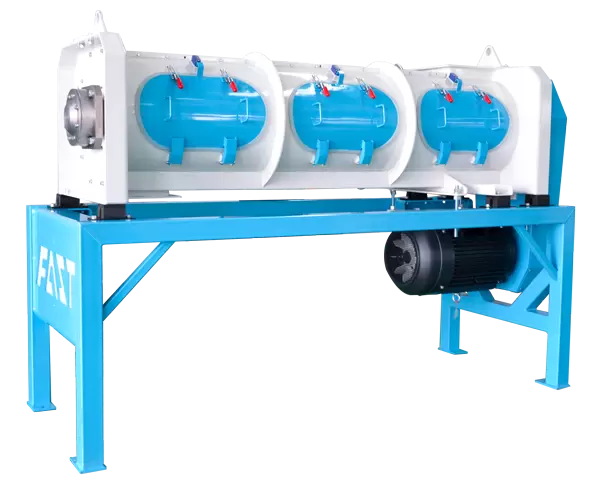Horizontal feed mixer is a kind of high-efficiency mixing equipment widely used in livestock industry and feed processing plant. It can evenly mix various powdered and granular feeds to improve feed quality. However, during long-term use, the equipment may have various faults, affecting production efficiency. Therefore, understanding the common faults of horizontal feed mixers and their solutions is crucial to the stable operation of the equipment. This article will analyze several common problems in detail and provide effective solutions to help farmers and feed processing companies maintain the efficient operation of the equipment.
Cause of failure:
Power supply problem: unstable voltage or loose line causes the mixer to fail to start normally.
Motor failure: The motor is damaged or the overload protection device is activated, making the equipment unable to operate.
Transmission system failure: The belt is loose or damaged, causing the motor power to be unable to be transmitted to the mixing shaft.
Solution:
Check the power supply: Make sure the power supply voltage is stable, the line connection is firm, and avoid connecting the equipment to high-power equipment at the same time.
Inspect the motor: If the motor heats up severely or makes abnormal noise, it may be necessary to replace the motor or check whether the overload protection device is malfunctioning.
Check the transmission system: replace loose or damaged belts, and adjust the tightness of the belts to ensure normal transmission.

Cause of failure:
Improper feeding order: The wrong order of feeding raw materials of different particle sizes and densities leads to uneven mixing.
Wear of the mixing shaft blades: After long-term use, the mixing blades may be worn or deformed, affecting the mixing effect.
Insufficient mixing time: If the mixing time is too short, the feed may not be fully mixed, resulting in uneven distribution.
Solution:
Optimize the feeding order: put the main material first, and then gradually add auxiliary materials and liquid ingredients to ensure uniform mixing.
Check the mixing blades: Check the wear of the mixing shaft and blades regularly, and replace them in time if damaged.
Extend the mixing time: Increase the mixing time appropriately to ensure that the feed is fully mixed and improve the uniformity.
Cause of failure:
moisture content is too high: Feed with high water content is easy to adhere to the discharge port, causing blockage.
Too much material accumulation: Residual materials have not been cleaned for a long time, resulting in accumulation and blockage of the outlet.
Discharge door failure: The discharge door is not sealed tightly or is blocked from opening, affecting normal discharge.
Solution:
Control moisture content: Ensure that the raw materials are dry to avoid blockage caused by excessive moisture.
Clean up accumulated materials regularly: Clean up residual feed after each use to avoid long-term accumulation.
Check the discharge door: Ensure that the discharge door is well sealed, lubricate and adjust it regularly to avoid jamming.
Cause of failure:
Bearing damage: Bearing wear or lack of lubricating oil causes abnormal noise during operation.
Loose stirring shaft: Loose connecting bolts or improper installation of bearings cause vibration and noise during stirring.
Gear wear: After long-term use, the gear gap increases or wear occurs, affecting the smoothness of the transmission.
Solution:
Check the bearings: Check the bearing wear regularly, replace if necessary, and add lubricating oil.
Tighten the bolts: Check all connecting bolts to ensure that all parts are stable and not loose.
Replace gears: If the gears are severely worn, they should be replaced in time and kept in proper lubrication.
Cause of failure:
The equipment is not sealed tightly: the sealing strips of the discharge port, mixing tank or connection parts are aged or damaged, resulting in material leakage.
Cracks in welding parts: After long-term use, cracks may appear in the welding parts of the equipment, resulting in material leakage.
The discharge door is not closed tightly: the discharge door is not completely closed, resulting in material overflow during the mixing process.
Solution:
Replace the sealing strip: Check and replace the sealing strip regularly to ensure that all connection parts are tight.
Repair the welding parts: If cracks are found, they should be welded and repaired in time to prevent further expansion.
Check the discharge door: Make sure that the discharge door is completely closed. If there is any damage, it should be repaired or replaced in time.
In order to ensure the long-term and stable operation of the horizontal feed mixer, the following maintenance measures are essential:
Regular lubrication: Regularly lubricate the bearings, gears and other parts to reduce wear and extend service life.
Clean the equipment: Clean the residual material after each use to prevent the accumulation of material from affecting the next use.
Check the motor: Regularly check whether the motor is overheated or vibrates abnormally to ensure the stability of the power system.
Tighten the bolts: Check the bolts at the joints of each component regularly to prevent loosening.
Avoid overload operation: Operate according to the rated load of the equipment to avoid damage caused by overload.
As an important equipment for the livestock industry and feed processing enterprises, maintenance and troubleshooting of horizontal feed mixers are essential. Regular inspections and timely repairs of faults can effectively increase the service life of the equipment and ensure the continuity of production. As a professional horizontal feed mixer factory, we are committed to providing customers with high-quality mixing equipment and after-sales service. If you encounter any problems during use, please feel free to consult our horizontal feed mixer company, and we will provide professional technical support and solutions.